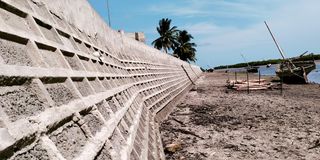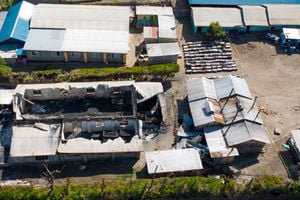Concerns raised over frequent destruction of Coast seawall

A section of the Pate Seawall in Lamu East Sub-County in this photo taken on August 1, 2024.
Frequent destruction of seawalls along the coastline in Lamu Archipelago and the Coast region in general has raised concerns among residents and environmentalists.
Environmentalists and climate change experts told Nation.Africa that increased storm surges as a result of sea level rise contributed by climate change have affected the coastline through increased wave action. This has also destroyed recreational beaches and buildings, some through erosion.

A section of Mokowe Depot Seawall in Lamu West.
Seawalls are usually built along the coastline to prevent water from the Indian Ocean from flowing into coastal residential areas.
In many cases, collapsed and neglected seawalls have left houses bordering the ocean underwater, or some have even been swept away by the seawater.

A section of the Pate Seawall in Lamu East Sub-County in this photo taken on August 1, 2024.
James Kamula, a climate change expert at the National Environment Management Authority (NEMA), says the only way to avoid the recurring cost of rehabilitating seawalls is for developers to ensure that they fully comply with the 60-metre setback line.
This will generally protect the riparian zone and the biodiversity within it, as well as protect the investment in the shoreline.
“I want to affirm that climate change is the cause of the frequent destruction and collapse of seawalls not only in Lamu but across the Coast region. Legally, all developments along the shoreline are supposed to observe the 60-metre setback line.
“Despite the legal provision, however, developers have over time continued to encroach on the shorelines from Lamu to Vanga in Kwale. Developers should comply with the law on protection of the shoreline riparian zone,” said Mr Kamula.
The Lamu County Government has expressed concern over the way it has been forced to spend money on frequent repairs to the seawalls.

A section of the Pate Seawall in Lamu East Sub-County in this photo taken on August 1, 2024.
Lamu Governor Issa Timamy reiterated that maintaining seawalls is a very expensive affair as developers have to keep rebuilding the walls whenever they erode and collapse due to wave action.
Mr Timamy called on partners to intervene and allocate enough funds to rehabilitate the seawalls, especially in Lamu Old Town, a United Nations Educational, Scientific and Cultural Organisation (Unesco) World Heritage Site, and save it from extinction.
“Lamu is getting very little allocation from the national treasury. We can’t cope with the cost implications involved in rehabilitating destroyed seawalls.
“Climate change is real. It’s leading to sea level rise. This forces us to increase the height of our seawalls from time to time and it’s expensive,” said Mr Timamy.

The dilapidated Mkokoni Island seawall in Lamu East Sub-County. Between Sh40 million and Sh60 million is needed in reconstructing the collapsed Mkokoni seawall in Lamu East Sub-County.
The Lamu County Government spends millions of shillings each year repairing and maintaining the seawalls.
Currently, the seawalls in Lamu Old Town have been rebuilt and raised to prevent high tides from flooding residential areas and businesses close to the sea.
In Mombasa, a seawall under construction near Kilifi Corner collapsed in April, killing one person.
Residents of Mkokoni Island in Lamu East Sub-county have condemned the deplorable state of their seawall.
Led by Kiunga Ward MCA Omar Bwana, the residents pleaded for the speedy reconstruction of their seawall to avert flooding.
“I am in talks with Governor Issa Timamy and partners, including the national government. We need between Sh40 million to Sh60 million to reconstruct the collapsed Mkokoni seawall,” said Mr Bwana.
Residents are also pushing for the construction of seawalls in the Kiunga and Ishakani areas.
In 2016, the national government undertook the construction of the Kizingitini seawall in Lamu East sub-county at a cost of Sh200 million.

A section of Mokowe Depot Seawall in Lamu West.
This was the third time the seawall was constructed after two previous walls collapsed due to constant pressure from high tides and strong winds in the area.
Other seawalls that have been repaired in Lamu include Kipungani, Matondoni, Pate, Faza and Ndau.
Due to the lack of seawalls, there have been repeated incidents of houses being swept away by strong ocean currents.
In 2000 and 2004, more than 20 houses were destroyed on Kizingitini Island, prompting the state to initiate the seawall project in the area.





